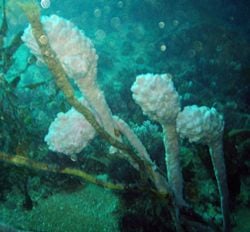Tunicate
| Tunicates | ||||||
|---|---|---|---|---|---|---|
 Sea Tulips, Pyura spinifera
| ||||||
| Scientific classification | ||||||
| ||||||
|
Ascidiacea |
Urochordata (sometimes known as tunicata and commonly called urochordates, tunicates, sea squirts or cunji) is the subphylum of saclike filter feeders with incurrent and excurrent siphons. There are also a few exceptions to this plan, like the predatory Megalodicopia hians, looking something like a cross between a jellyfish and a Venus Flytrap. They are members of the phylum Chordata, which also includes lancelets, hagfish and all vertebrates including man. They are now considered as the closest relatives to craniates (i.e. hagfish and vertebrates), having dethroned lancelets from that position. As with other chordates, tunicates possess a notochord during their early stages of development.
They lack segmentation, even in the tail. Metanephridia are absent. The original coelom is degenerated to a pericardial cavity and gonads. Except for the pharynx, heart and gonads, the organs are enclosed in a membrane called an epicardium, which is surrounded by a jelly like matrix known as mesenchyme. The motile larval stages may have the appearance of a tadpole, whereas the adult stage has a barrel-like, sedentary form. They feed by filtering sea water through a gill basket.
Description
Most tunicates are hermaphroditic. The eggs are kept inside their body until they hatch, while sperm is released into the water where it fertilises other individuals when brought in with incoming water.
Tunicates have two openings in their body cavity: an incurrent and an excurrent siphon. The incurrent siphon is used to intake food and water and the excurrent siphon expels waste and water. The tunicate's primary food source is plankton. Plankton gets entangled in the mucus secreted from the endostyle. The tunicate's pharynx is covered by miniature hairs called ciliated cells which allow the consumed plankton to pass down through to the esophagus. Tunicates are also the only animals able to create cellulose.
Some larval forms appear very much like primitive chordates or hemichordates with a notochord (primitive spinal cord). Superficially the larva resemble small tadpoles. Some forms have a calcereous spicule that may be preserved as a fossil. They have appeared from the Jurassic to the present, with one proposed Neoproterozoic form, Yarnemia.
The larval stage ends when the tunicate finds a suitable rock to affix to and cements itself in place. Many physical changes occur to the tunicate's body, one of the most interesting being the digestion of the cerebral ganglion previously used to control movement. From this comes the common saying that the sea squirt "eats its own brain".[1]
Once grown, adults can develop a covering, called a tunic, to protect themselves from enemies.
In some classes, the adults remain pelagic (swimming or drifting in the open sea), although their larvae undergo similar metamorphoses to a higher or lower degree.
Tunicate blood is particularly interesting. It contains high concentrations of the rare metal vanadium and vanadium-associated proteins. Some Tunicates can concentrate vanadium up to a level one million times that of the surrounding seawater. It is still unknown how they do this or why.
They are usually divided into the following classes.
- Ascidiacea (Aplousobranchia, Phlebobranchia, and Stolidobranchia),
- Thaliacea,
- Appendicularia (Larvacea)
- Sorberacea.
Newer evidence indicates that the Ascidiacea is an artificial group. The new classification would then look like this.
- Stolidobranchia,
- Phlebobranchia and Thaliacea,
- Aplousobranchia and Appendicularia,
- Sorberacea would belong somewhere in Ascidiacea, or be in a taxon on its own.
For the moment, the traditional classification is followed.
Invasive species
Over the past few years, urochordates (notably of the genus Didemnum) have been invading coastal waters in many countries, and are spreading quickly. These mat-like organisms can smother other sea life, have very few natural predators, and are causing much concern. [1] Transportation of invasive tunicates is usually in the ballast water or on the hulls of ships. Current research indicates that many tunicates previously thought to be indigenous to Europe and the Americas are, in fact, invaders. Some of these invasions may have occurred centuries or even millenia ago. In some areas, tunicates are proving to be a major nuisance in aquaculture operations. [2] [3]
Chemical derivatives
Tunicates have been found to contain a host of potentially significant compounds, among which are:
- Didemnins (various cancers, antivirals, immunosuppressants)
- Aplidine (various cancers)
- Esteinascidin 743 (various cancers)
ReferencesISBN links support NWE through referral fees
- Dennis. 2003. pers. comm. Marine Science Dept. Orange Coast College.
- Solomon, E., L. Berg, D. Martin. 2002. Biology. Brooks/Cole.
External links
- Error in the Genealogy of Human
- washington.edu page on tunicates
- Ascidians.com has pictures of species around the world
- Squirt Alert: Science News Online, Dec. 24, 2005
- Ode to the Cunji, in Macquarie University Biology Bytes June 1998
Credits
New World Encyclopedia writers and editors rewrote and completed the Wikipedia article in accordance with New World Encyclopedia standards. This article abides by terms of the Creative Commons CC-by-sa 3.0 License (CC-by-sa), which may be used and disseminated with proper attribution. Credit is due under the terms of this license that can reference both the New World Encyclopedia contributors and the selfless volunteer contributors of the Wikimedia Foundation. To cite this article click here for a list of acceptable citing formats.The history of earlier contributions by wikipedians is accessible to researchers here:
The history of this article since it was imported to New World Encyclopedia:
Note: Some restrictions may apply to use of individual images which are separately licensed.
